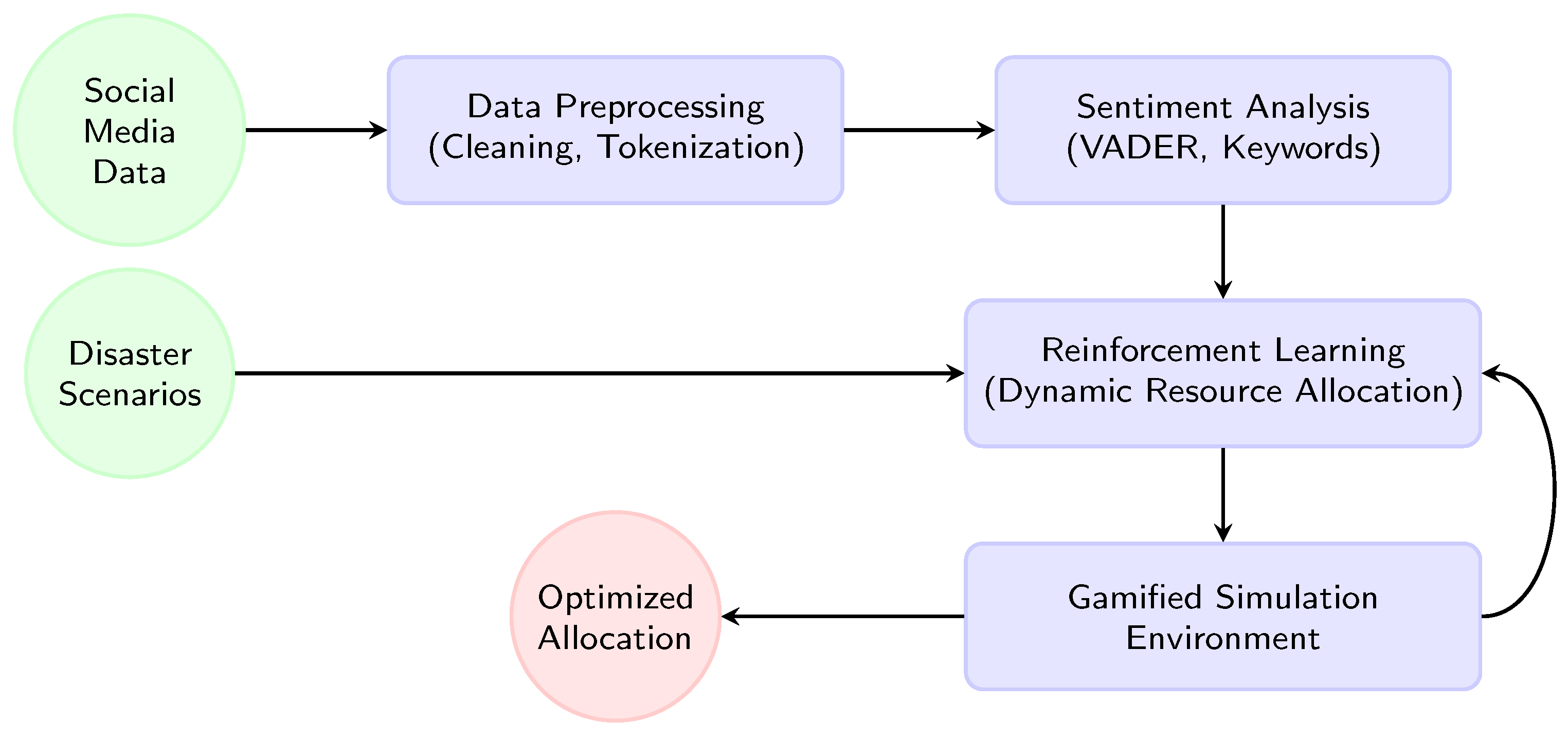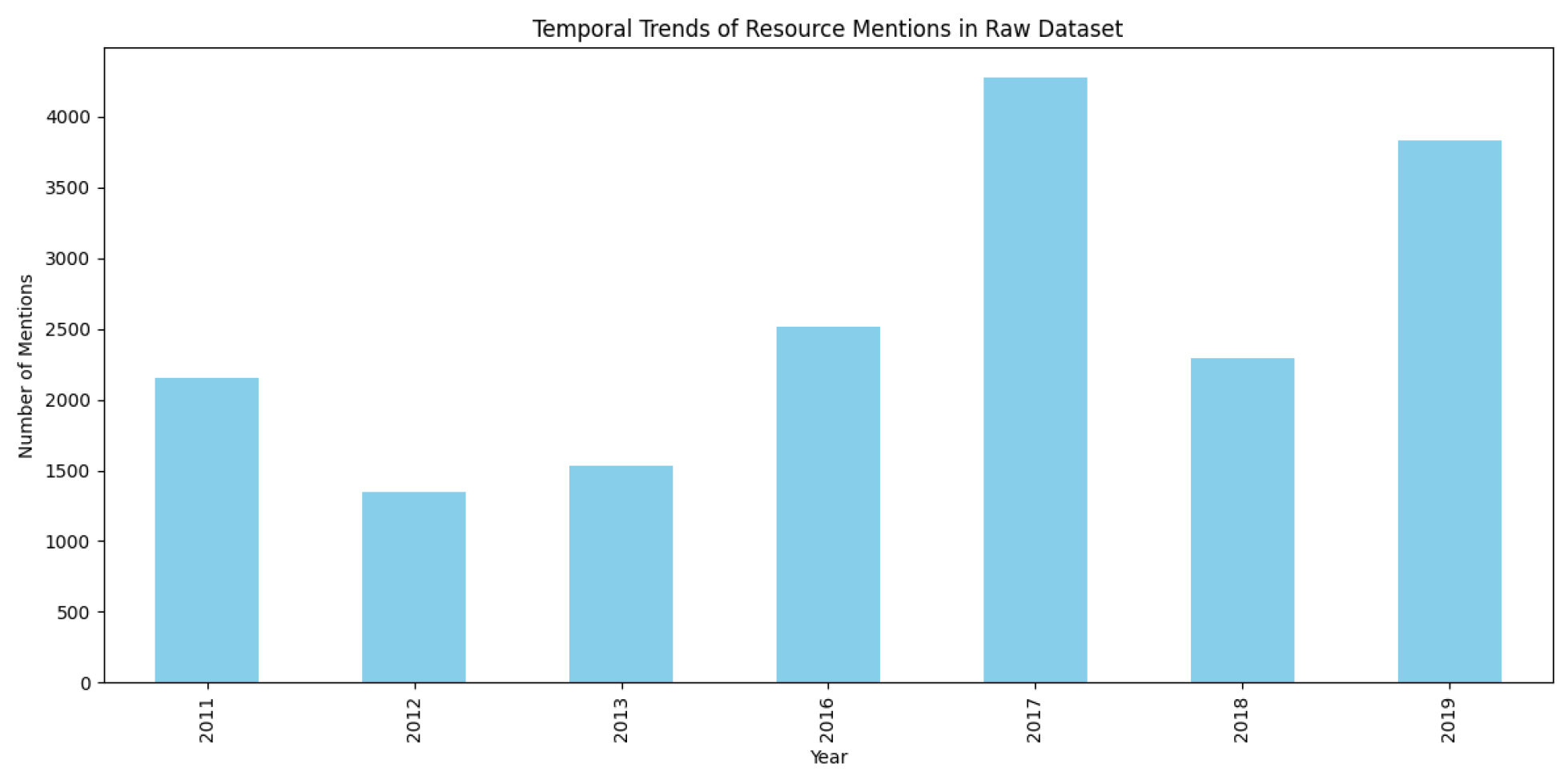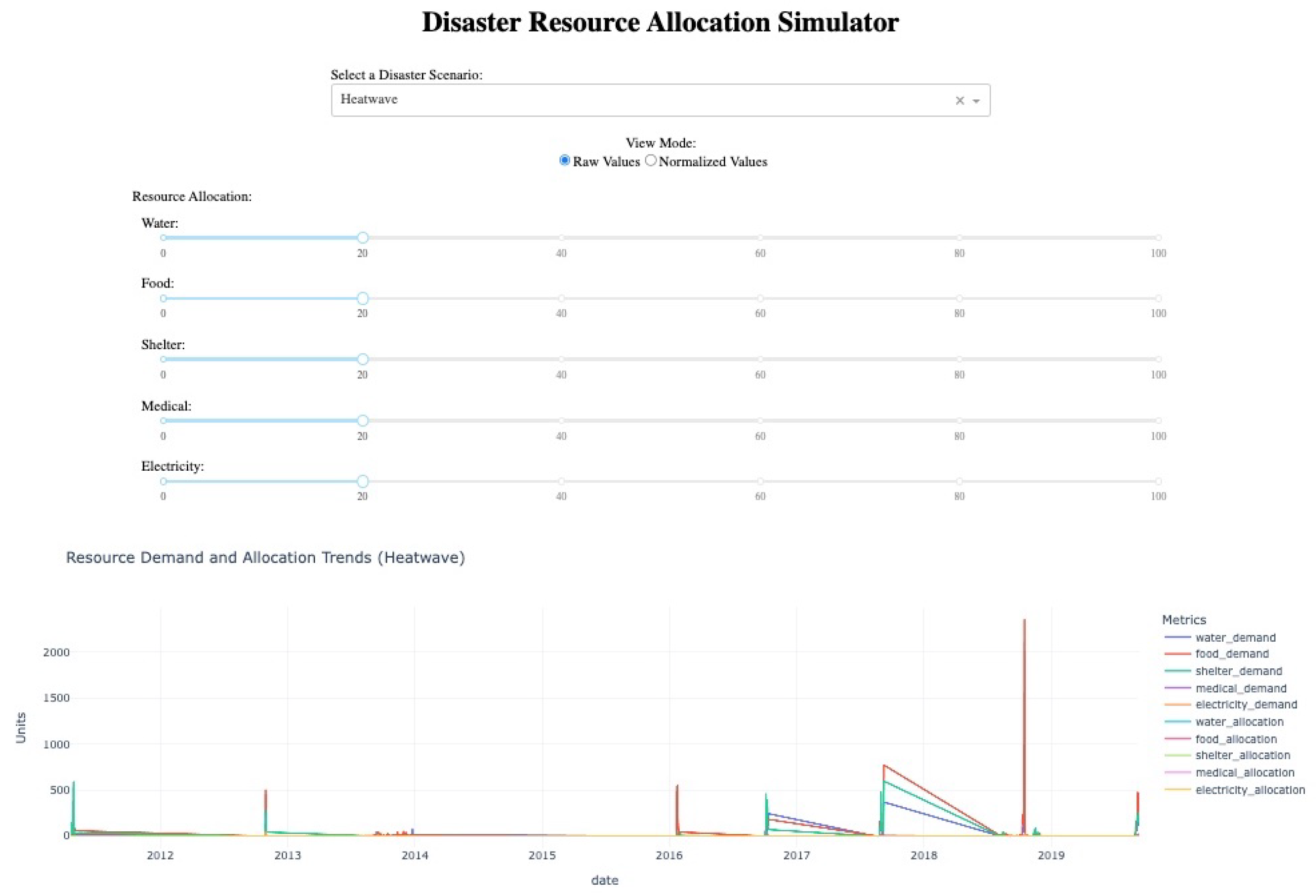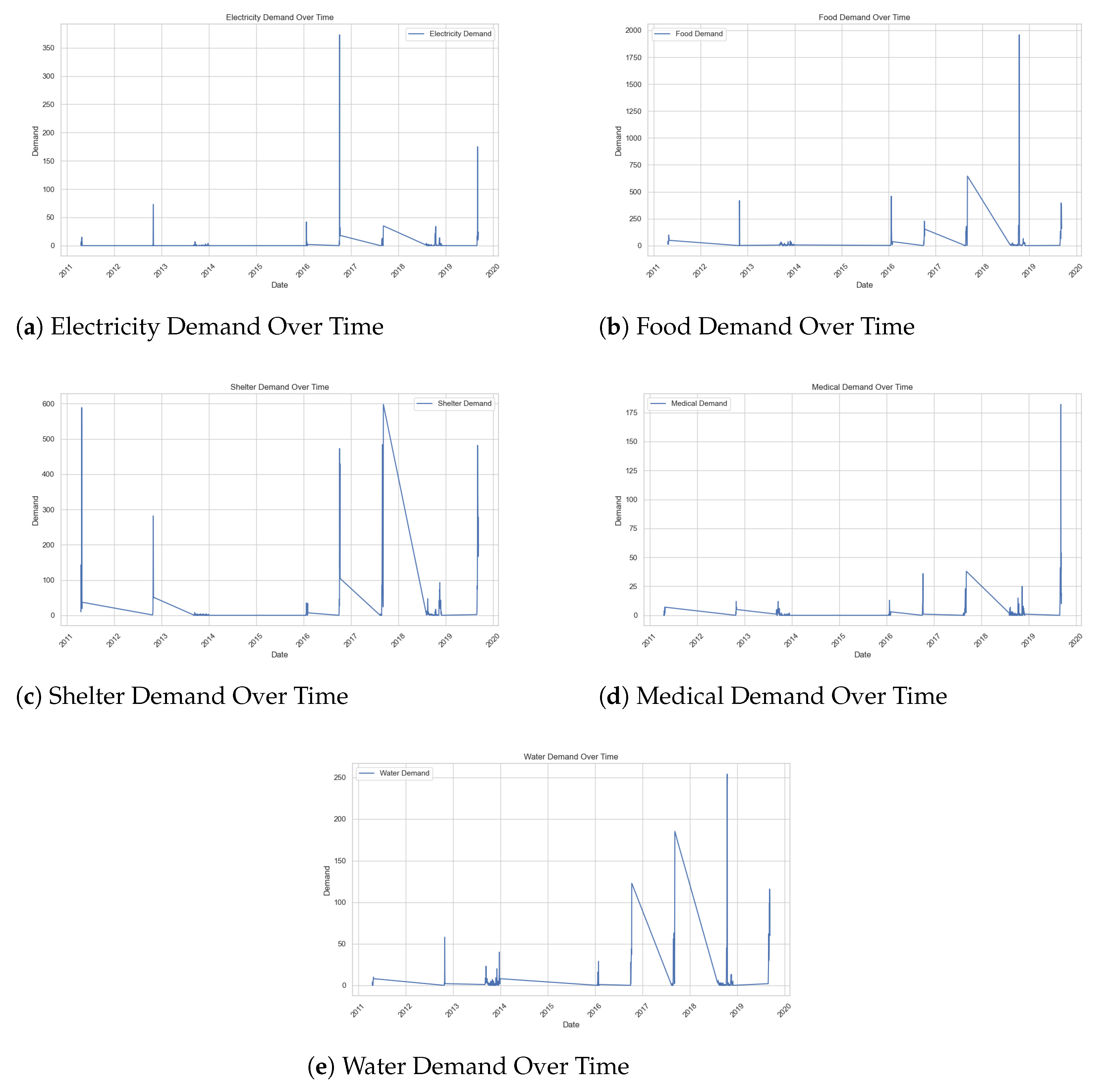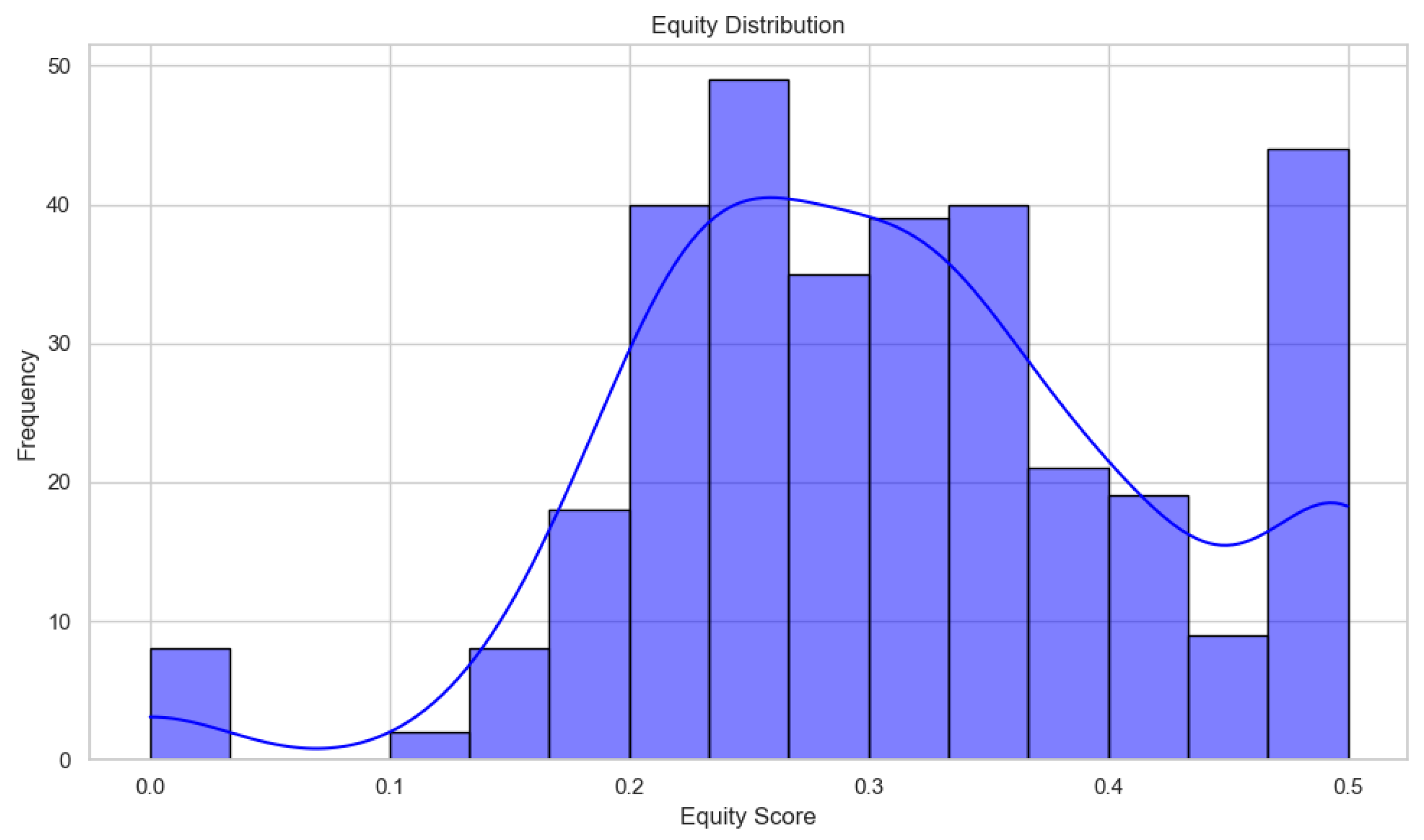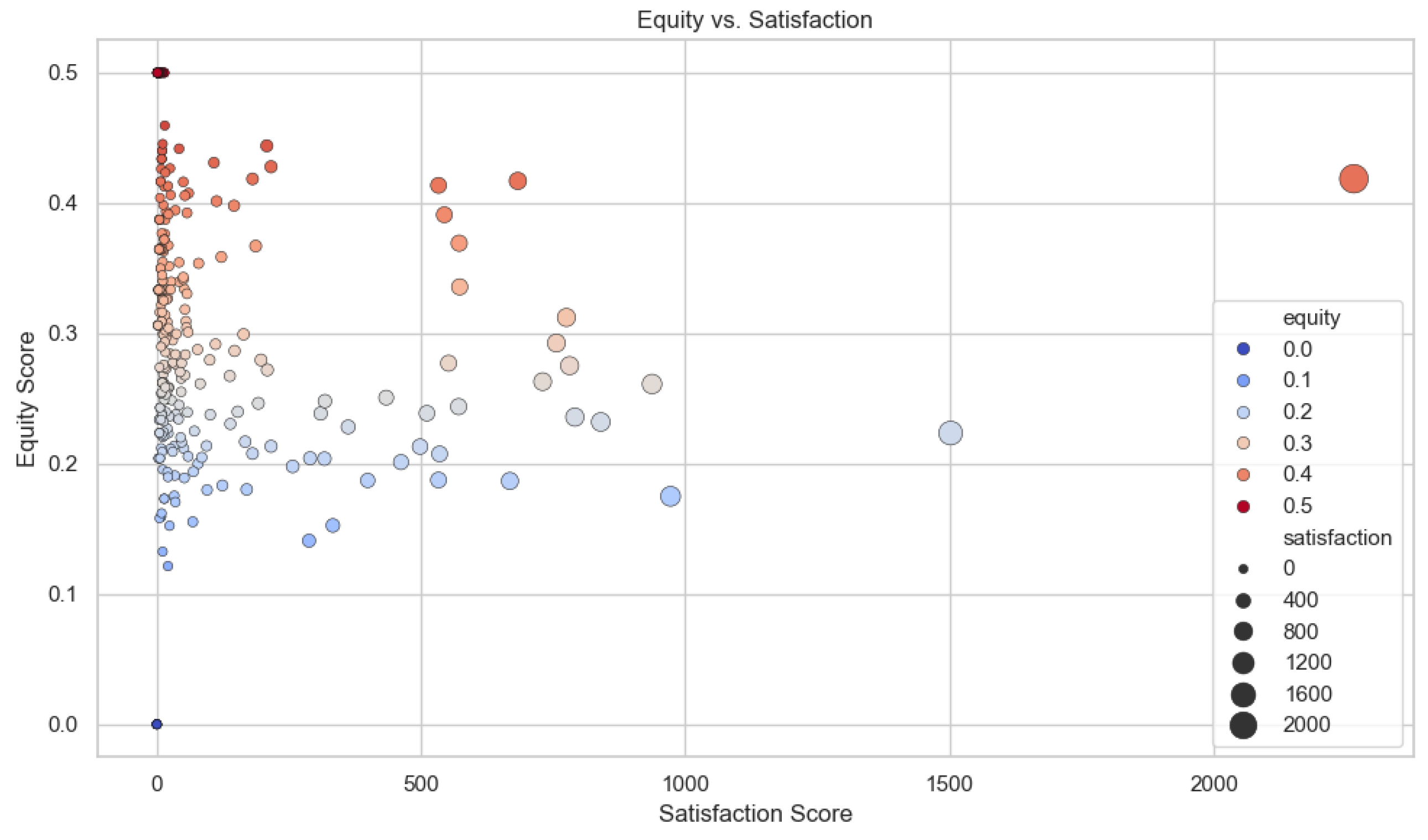1. Introduction
Disasters, defined as disruptions that exceed a community’s capacity to cope with their own resources, present significant challenges to global communities, requiring swift and effective responses to mitigate human suffering and optimize resource distribution [
1,
2]. Among the most pressing issues is the fair and efficient deployment of critical resources, including water, food, shelter, medical supplies, and electricity. Conventional allocation frameworks frequently depend on static or inflexible rules and often fail to capture the rapidly shifting conditions of disaster environments [
3], resulting in unequal coverage for vulnerable populations and widespread inefficiencies.
Addressing these shortcomings is central to sustainable development efforts, where disaster response must not only fulfill immediate humanitarian needs but also strengthen long-term resilience. Equitable resource allocation aligns with multiple United Nations Sustainable Development Goals (SDGs), most notably SDG 11 (Sustainable Cities and Communities) and SDG 13 (Climate Action) [
4], helping to ensure that marginalized communities are not left behind. By integrating data-driven insights into the distribution process, resource waste can be minimized, and local capacities can be bolstered to better manage future crises. This research echoes place-based resilience models [
5] by considering the unique social, economic, and geographical factors influencing community recovery.
The advancement of computational methodologies and the ubiquity of social media platforms have expanded the potential for innovative solutions in disaster response [
6]. Real-time social media sentiment analysis provides a window into the immediate concerns and priorities of disaster-stricken populations, enabling a granular and time-sensitive view of resource demands. Recent breakthroughs in natural language processing (NLP) [
7,
8,
9] have demonstrated strong capabilities for extracting meaningful insights from massive text corpora, although the application of such insights to dynamic resource allocation remains relatively unexplored. Additionally, the complexity of disaster environments—with high-dimensional state spaces and uncertain conditions—necessitates robust and adaptive algorithms for decision-making.
In this context, reinforcement learning (RL) offers a powerful framework for iteratively refining strategies based on feedback from the operating environment [
10]. RL has yielded significant progress in robotics, healthcare, and logistics [
11], and it increasingly shows promise in emergency management applications [
12]. Advanced RL techniques, such as Deep Q-Networks [
13] and Proximal Policy Optimization [
14], are particularly well suited for handling the continuous adaptation required by disaster scenarios. By coupling these algorithms with real-time sentiment data, responders can adopt a more proactive and needs-based approach to allocating scarce resources.
Building on these foundations, this work proposes a novel framework that marries NLP-based sentiment analysis, RL-driven decision-making, and gamification to manage resource distribution in crisis settings. By drawing on real-time inputs from social media, the system identifies surges in demand for vital resources and adapts allocations according to both urgency and equity considerations. A gamified simulation environment further enriches this approach, allowing decision-makers, policymakers, and community stakeholders to test various strategies, visualize outcomes, and iteratively improve the allocation policies [
15].
Specifically, the contributions of this paper are as follows:
Results indicate that the proposed framework outperforms traditional allocation methods in terms of equity and satisfaction while also enhancing the transparency and adaptiveness of decision-making processes. By combining sentiment analysis, reinforcement learning, and gamification into a cohesive platform, this approach provides a comprehensive solution for stakeholders seeking to optimize disaster relief efforts. Moreover, the emphasis on equitable and sustainable practices aligns the framework with broader global agendas, reinforcing the importance of resilient, data-driven crisis management strategies.
2. Related Work
Effective disaster response hinges on optimizing resource allocation in highly dynamic and uncertain environments [
18,
19]. Although substantial research has explored the utility of sentiment analysis, reinforcement learning, and gamification independently, there remains a dearth of studies that integrate these approaches into a unified framework. This section provides a critical overview of the existing literature, highlighting progress in each domain and underscoring the need for an integrated, data-driven system that can adapt to real-time disaster conditions.
2.1. Sentiment Analysis in Disaster Management
Social media platforms—such as Twitter, Facebook, and Reddit—have emerged as crucial channels for gauging public sentiment and identifying urgent needs during disasters. By capturing firsthand, real-time observations from affected populations, social media data offer a unique window into emergent crises [
20,
21]. Sentiment analysis transforms this raw content into structured insights that can inform resource prioritization and relief measures.
A foundational example is provided by Ragini et al. [
19], who correlate spikes in negative sentiment with heightened demands for life-saving goods and medical support. Yum [
22] takes this a step further, emphasizing the role of demographic segmentation in interpreting social media sentiment. By disaggregating data based on user profiles and locations, Yum’s approach enables more targeted resource distribution, shedding light on pockets of high vulnerability or urgent need. Likewise, Burel and Alani [
16] propose the Crisis Event Extraction Service (CREES) to automatically detect and classify crisis-related messages; however, their system remains largely an analytical pipeline without direct ties to dynamic decision-making frameworks.
In practice, sentiment analysis techniques vary widely. Simple lexicon-based methods (e.g., VADER) are user-friendly but can falter in the face of sarcasm, regional dialects, and informal expressions [
23]. More advanced solutions rely on deep learning—such as transformer-based architectures—to parse context in short, noisy messages more effectively [
24]. Despite these methodological improvements, a significant gap persists: turning near-real-time sentiment signals into immediate, adaptive actions for resource distribution. Often, sentiment findings remain siloed in after-action reports rather than informing operational systems in real time.
2.2. Reinforcement Learning in Dynamic Environments
Reinforcement learning is particularly suited for domains involving uncertainty, limited information, and sequential decision-making [
10]. By iteratively interacting with an environment, an RL agent learns policies that maximize a cumulative reward signal, making it adept at dynamic allocation tasks under changing conditions. In commercial sectors, RL has been employed for supply-chain optimization, ride-hailing dispatch, and energy management [
25,
26], showing its ability to handle complex real-world scenarios.
In disaster management, RL-based techniques have been explored for evacuation routing and relief distribution, albeit on a relatively limited scale [
27,
28]. These studies often demonstrate improved responsiveness compared to static rule-based systems, particularly when addressing fluctuating demands for resources. However, many RL approaches in this domain still rely on relatively static models that do not incorporate continuous data streams, such as social media sentiment. Because public sentiment can offer near-real-time signals about shortages, priorities, and stress points, integrating RL with sentiment data presents a promising strategy for more agile disaster response.
Emerging paradigms in RL—such as actor–critic architectures, model-based methods, and hierarchical RL—could further enhance this adaptability by partitioning large or multiregional crises into manageable subproblems, each governed by local policies aligned with overarching global objectives. Such hierarchical schemes could refine resource distribution strategies in disaster contexts, balancing timeliness, equity, and efficiency.
2.3. Gamification in Policy Decision-Making
Gamification incorporates game-design elements (e.g., point systems, leaderboards, and interactive simulations) into serious or non-entertainment contexts, aiming to boost stakeholder engagement and motivation [
29]. Established fields like urban planning and environmental policy have leveraged gamified simulations to help stakeholders collaboratively experiment with different interventions, observe outcomes in real time, and appreciate the trade-offs associated with various policy choices.
In disaster management, gamification has primarily been explored for public education and high-level scenario planning [
30]. Tsai et al. [
31], for example, developed a serious game-based learning package for flood disaster education. Although such tools can effectively communicate potential hazards and encourage preparedness, they seldom integrate predictive analytics or real-time data streams, such as those derived from social media. Consequently, these implementations fall short of leveraging the full potential of interactive platforms to inform tactical decisions in fast-evolving disasters. By embedding gamification in an RL-based system that dynamically processes sentiment cues, decision-makers could not only visualize resource allocation outcomes but also actively
steer these allocations in response to live crisis data [
32].
2.4. Current Gaps and Research Opportunities
Although each domain discussed—sentiment analysis, reinforcement learning, and gamification—has individually contributed to disaster management, critical barriers remain to fully realizing their collective potential:
While sentiment analysis offers valuable clues regarding immediate needs, few studies harness these signals to actively shape resource allocation in a continuous feedback loop.
Existing RL models for disaster response often ignore fluctuating public sentiment and lack the capacity to update policies as these sentiments change.
Most gamification efforts in disaster management focus on theoretical or educational outcomes, leaving a gap in practical, interactive decision-support tools that can handle real-time data streams.
By merging sentiment analysis, RL, and gamification into a single, cohesive system, this research aims to fill these gaps and enable agile, evidence-based decision-making. The envisioned framework would not only process live sentiment data to detect emergent needs but also employ advanced RL algorithms to dynamically reallocate resources, all within an engaging and transparent gamified platform. Such an approach has the potential to reduce inefficiencies, prioritize vulnerable populations, and elevate the overall effectiveness of disaster relief efforts—ultimately advancing the frontiers of both humanitarian aid and computational intelligence.
3. Methodology
The proposed framework aims to advance sustainable disaster management by optimizing resource allocation through real-time sentiment analysis and adaptive reinforcement learning. By emphasizing equitable distribution, the framework minimizes resource misallocation and ensures that impacted regions receive balanced support—ultimately enhancing both short-term relief operations and long-term resilience. This methodological section elucidates each component of the system with details of the data pipeline, RL architecture, and the gamified simulation environment.
To visually summarize the proposed framework,
Figure 1 illustrates the integration of sentiment analysis, reinforcement learning, and a gamified simulation platform for disaster resource allocation. Each subsystem provides specific functionalities in achieving adaptive and equitable resource distribution, with real-time feedback loops to boost system responsiveness and performance.
As depicted in
Figure 1, the system integrates the following core components:
Social Media Data: Disaster-related tweets and posts serve as the real-time data source, capturing public sentiment and resource needs.
Data Preprocessing and Sentiment Analysis: Text data undergo cleaning, tokenization, and sentiment scoring (e.g., via VADER). This stage translates raw user-generated text into actionable demand metrics for specific resources, such as water, food, shelter, medical supplies, and electricity.
Reinforcement Learning Framework: The sentiment-driven resource demands feed into an RL model that learns to balance satisfaction (meeting demand) and equity (fair distribution across regions).
Gamified Simulation Environment: A user-friendly simulation platform enabling interactive testing of resource allocation strategies, visualization of real-time outcomes, and stakeholder engagement.
Output: The system outputs an adaptive, context-aware resource allocation plan that continually updates as disaster conditions evolve.
Collectively, these elements ensure a holistic and scalable approach to disaster management by addressing both high-level strategic planning and on-the-ground operational adaptability.
3.1. Data Collection
A subset of the Natural Hazards Twitter Dataset [
33] forms the primary data source, comprising nearly 50,000 disaster-related tweets generated during hurricanes, floods, wildfires, and other large-scale emergencies. These tweets contain timestamp, textual content, and limited geolocation metadata, providing a real-time lens into public perceptions and immediate resource requirements.
3.1.1. Initial Dataset Analysis
Prior to filtering, the dataset underwent an exploratory analysis to assess its coverage, topical scope, and temporal density. Key insights include the following:
Time Span: Tweets from 2011 to 2019, capturing a diverse array of disasters and peak event periods.
Geographic Spread: Global coverage with a concentration in disaster-prone regions (e.g., areas with frequent hurricanes).
Topical Breadth: Various resource demands, emotional responses, and general commentary.
3.1.2. Data Filtering and Reduction
To ensure relevance and quality, several filtering steps were applied:
Keyword Filtering: Only tweets referencing critical resources (water, food, shelter, medicine, electricity) were retained, focusing the dataset on actionable demands.
Data Quality Checks: Tweets lacking valid timestamps, clear geolocation cues, or complete metadata were removed to maintain consistency in temporal and spatial analyses.
Deduplication: Duplicate or near-duplicate content was eliminated to avoid overweighting specific messages.
Following the preprocessing steps, the dataset was refined to a total of 34,122 tweets, of which 17,960 explicitly mentioned at least one critical resource. This balance between dataset size and quality ensures robust downstream analysis while maintaining the dataset’s relevance to disaster scenarios. A summary of the dataset, including key statistics and resource-related keyword distributions, is presented in
Table 1.
To better contextualize disaster responses, the dataset’s timing of tweets relative to disaster events was analyzed using the publicly available Natural Hazards Twitter Dataset [
33]. The dataset includes tweets collected within user-defined time intervals tailored to specific disasters. For instance, during Hurricane Harvey, tweets were gathered from 10 August 2017 to 9 September 2017, spanning approximately two weeks before the hurricane’s landfall on 25 August 2017 and two weeks afterward. This timeframe effectively captures both pre-disaster anticipation and post-disaster recovery phases, providing a comprehensive view of evolving public sentiment. Such temporal details enhance the dataset’s value by aligning sentiment data with immediate and long-term disaster response needs.
Key statistics of the final dataset are summarized below, with
Figure 2 and
Figure 3 illustrating temporal trends and keyword distributions, respectively.
Total Tweets: 34,122
Resource-Specific Tweets: 17,960 (approx. 52.6%)
Temporal Coverage: 2011 to 2019
Keyword Counts: Food is the most frequently cited resource, followed by shelter and water.
The deliberate curation of the dataset ensures that subsequent analyses focus on urgent needs in disaster contexts to reflect both the frequency and the intensity of demand signals over time.
3.2. Data Preprocessing
Preprocessing ensures that tweets are standardized, noise is removed, and sentiment is accurately captured, thus enabling reliable downstream analyses.
3.2.1. Data Cleaning
Raw tweets were cleaned using the following steps:
Removal of URLs, Mentions, and Hashtags: Regular expressions strip out these elements to reduce noise.
Lowercasing and Tokenization: Ensures uniform text representation across tweets.
Language Filtering: Only English tweets were retained to avoid ambiguity in sentiment scoring.
3.2.2. Resource Keyword Extraction
A domain-specific dictionary of resource-related keywords (and their synonyms) was used to identify tweets referencing water, food, shelter, medical aid, and electricity. This approach was validated by domain experts, yielding a precision of 92% in identifying relevant content.
3.2.3. Sentiment Scoring
Sentiment analysis was performed using VADER [
23], which computes a compound score in the range
. Tweets with negative or neutral sentiment were tagged as expressing unmet demand, whereas highly positive scores indicated fulfilled needs or positive outcomes.
3.2.4. Data Aggregation and Representation
Annotated tweets were aggregated by region and date, yielding a time-series representation. For each region–day combination,
This standardized format supports temporal analyses, RL state encoding, and scenario-based simulation.
3.3. Reinforcement Learning Framework
3.3.1. State Space
Each state
encapsulates the resource demands across
R regions at time
t, as well as relevant sentiment indicators:
may include the average sentiment score per region or an embedding vector capturing nuanced shifts in language usage.
3.3.2. Action Space
Actions involve allocating discrete quantities of each resource to
R regions. Following [
34] and others, we discretize the allocation levels (e.g.,
) to manage computational complexity while still capturing critical gradients in resource distribution.
3.3.3. Reward Function
The RL agent balances two key objectives:
Demand Satisfaction: Proportion of total resource needs met, incentivizing coverage of the most urgent demands.
Equity: Uniformity of allocations across regions, promoting fairness and preventing under-served areas.
Mathematically,
where
controls the trade-off between maximizing coverage and maintaining equitable distribution. Equity is quantified through the inverse coefficient of variation, as follows:
with
as the standard deviation of allocations,
the mean, and
a small constant to avoid division by zero.
Balancing equity and satisfaction often requires compromising one to optimize the other. As Bertsimas et al. [
35] argue, the trade-off between equity and satisfaction reflects a broader tension in operational management. For instance,
High Satisfaction, Low Equity: allocating resources primarily to high-demand regions maximizes satisfaction but may leave other regions under-served, reducing equity.
High Equity, Moderate Satisfaction: ensuring fair distribution across regions can lower overall satisfaction as resources may not fully meet high-demand areas.
A critical insight from this study is the inherent trade-off between equity and satisfaction in resource allocation. High satisfaction can be achieved by prioritizing high-demand regions, but this approach risks neglecting less populated areas, thereby reducing equity. Conversely, equitable distributions may lower satisfaction scores by under-serving regions with higher demand. These trade-offs reflect the tension between efficiency and fairness, a challenge central to disaster management. By quantifying these metrics and visualizing their interplay, the framework empowers decision-makers to balance competing objectives effectively. The gamified simulation platform further enhances this decision-making process, allowing users to dynamically adjust allocation strategies and observe real-time outcomes.
3.3.4. Training Procedure
Q-learning [
10,
36] was employed to train the RL agent:
where
is the learning rate and
is the discount factor. Key hyperparameters (
Table 2) were tuned via grid search and validated in pilot simulations:
Learning Rate: Balances stability and adaptability in updating Q-values.
Discount Factor: Emphasizes cumulative benefits over extended disaster timelines.
Exploration Rate: Decreases from to over training, ensuring sufficient exploration before exploiting the learned policy.
The agent was trained over 10,000 episodes, each simulating diverse disaster scenarios with fluctuating resource demands. Convergence was assessed using the mean squared error of Q-value updates, and training terminated upon reaching a threshold of .
3.4. Gamified Simulation Environment
A key innovation of this work is the gamified simulation environment, designed to enhance stakeholder engagement and facilitate transparent policy decisions. Built with the Dash framework, this platform provides an interactive, web-based interface for exploring different allocation strategies:
Real-Time Visualization: Time-series graphs illustrate resource demands, allocation levels, and the resulting satisfaction/equity metrics across regions.
Parameter Adjustment: Users can modify , the equity–satisfaction trade-off parameter, or manually allocate resources to compare performance against the RL-driven policy.
Scenario Simulation: Synthetic disaster scenarios, where resource demands evolve dynamically, enable stress-testing of the learned RL policy under various crisis conditions.
As recommended in [
37], incorporating game mechanics (e.g., scenario-based challenges, achievement badges for meeting certain equity thresholds) fosters deeper engagement among non-expert stakeholders, encouraging them to iterate on resource allocation strategies and learn from real-time feedback.
The live dashboard (
Figure 4) updates allocation metrics as the RL agent or human users alter distributions, highlighting the immediate impact on community satisfaction and equity. Furthermore, the environment supports the real-time integration of incoming sentiment data, reinforcing the central premise of adaptive decision-making.
3.5. Experimental Setup
To evaluate the effectiveness of the proposed system, a set of controlled experiments was designed:
Baselines:
- –
Uniform Allocation, where resources are distributed equally across all regions.
- –
Rule-Based Allocation, where allocations rely on historical demand averages.
Evaluation Metrics:
- –
Satisfaction: Fraction of total resource demand fulfilled.
- –
Equity: Fairness of allocation, measured via the inverse coefficient of variation.
- –
Adaptability: System responsiveness to real-time sentiment fluctuations.
Implementation Details: Python libraries (NumPy, Pandas, and Dash) were used for data management and visualization. The Q-learning algorithm was implemented in a modular manner, allowing easy integration with the simulation platform.
Each baseline and the RL-based approach were tested on identical synthetic disaster scenarios (varying intensities and durations). The next section presents quantitative results comparing the performance of the proposed method against these baselines, thereby verifying the efficacy and adaptability of the integrated framework.
The methodology comprises four intertwined pillars: (1) Data Collection and Preprocessing, ensuring the extraction of high-quality, sentiment-labeled resource demands; (2) Reinforcement Learning, orchestrating adaptive allocation decisions by balancing equity and satisfaction; (3) Gamified Simulation, engaging diverse stakeholders in interactive scenario testing; and (4) Experimental Validation, benchmarking the approach against conventional baselines. Together, these elements form a robust, evidence-based system that aspires to strengthen disaster management practices by leveraging the power of real-time analytics, advanced AI, and user-centered design.
4. Results and Discussion
This section presents the findings from the sentiment-driven disaster resource allocation framework, focusing on how the system captures resource demand patterns, balances equity and satisfaction, leverages reinforcement learning, and facilitates stakeholder engagement via a gamified simulation environment. Each subsection addresses a critical dimension of the proposed approach, underscoring the framework’s potential for operational impact in real-world disaster scenarios.
4.1. Resource Demand Analysis
A key objective of this research is to leverage sentiment analysis for identifying time-sensitive resource demands during disasters.
Figure 5a–e illustrate the temporal trends of five essential resources—electricity, food, shelter, medical, and water—revealing fluctuations in public demand associated with disaster occurrences. These trends were extracted from tweets using the sentiment-driven method discussed previously, aligning with established research that demonstrates social media’s capacity to capture real-time disaster needs [
38,
39].
Electricity Demand: As illustrated in
Figure 5a, electricity demand exhibits a noticeable spike in 2013, underscoring a potential system-wide power shortage or infrastructure failure. The sporadic appearance of electricity-related tweets suggests that such demands, while critical, can be episodic and closely tied to specific high-impact events such as large-scale storm outages.
Food and Shelter Demand:Figure 5b,c display recurring peaks in food and shelter demands, notably concentrated in 2013 and 2017. These results confirm the fundamental importance of these resources for immediate survival and longer-term stability in post-disaster conditions. The temporal patterns observed also highlight seasonal and event-driven spikes, which decision-makers can use to anticipate urgent relief measures.
Medical Demand: Compared to other resources, medical demand appears relatively subdued until 2019, where a pronounced surge is evident (
Figure 5d). This anomaly likely corresponds to a health-related disaster or a scenario producing significant casualties. While medical aid may not be as universally demanded as food or shelter, this spike underscores the essential nature of rapidly scaling medical services under certain disaster conditions.
Water Demand:Figure 5e underscores water’s pivotal role across multiple disaster events. Elevated demand peaks in 2017, for example, potentially coincide with heatwaves or urban flooding that compromise safe drinking water. The consistency of these spikes across different events confirms water’s criticality for public health and underscores the need for prioritizing potable water distribution during emergencies.
Collectively, these findings validate the utility of employing sentiment-driven analysis to pinpoint resource needs in real time. The alignment between temporal demand patterns and known disaster timelines reinforces the reliability of the proposed approach, enabling humanitarian organizations and policymakers to prioritize logistical and operational decisions accordingly.
4.2. Equity and Satisfaction Analysis
Assessing the extent to which resources are allocated fairly and adequately is vital for disaster management. In the proposed system,
equity measures the uniformity of allocation across different regions, while
satisfaction captures the proportion of total demand that is fulfilled.
Figure 6 and
Figure 7 depict the equity score distribution and the relationship between equity and satisfaction, respectively.
4.2.1. Equity Distribution
Figure 6 reveals that most equity scores lie within the 0.1–0.5 range, indicating moderate but noticeable variability in allocations across regions. Clusters of higher equity within this distribution are often associated with time periods in which the RL framework successfully balanced multiple competing demands. The data further suggest that achieving equity depends on both the availability of resources and the complexity of regional demands. In scenarios where resources are severely constrained or concentrated in a specific area, equity scores may decline.
4.2.2. Equity vs. Satisfaction
Figure 7 investigates the interplay between equity and satisfaction. A positive clustering near high satisfaction scores indicates that the RL approach successfully meets a large proportion of demands while maintaining moderate or high equity. Nonetheless, several outliers display scenarios where either severe imbalances in regional needs or resource scarcity lead to lower equity. These data points underscore the importance of carefully tuning the RL reward function to manage trade-offs between fair distribution and overall demand coverage, consistent with the literature addressing resource allocation complexities [
40].
In summary, these findings confirm that sentiment-driven RL allocation can enhance real-time decision-making by aligning resource deployment with emergent needs, balancing high satisfaction for essential goods and services while maintaining an acceptable level of equity. Such balanced performance is particularly useful in large-scale disasters where over-prioritizing certain regions or resources might result in systemic inequities over time.
4.3. Reinforcement Learning Performance
The core of this work lies in the integration of sentiment data into an RL framework for decision-making.
Table 3 presents a representative Q-table after model convergence, illustrating how the RL agent assigns value estimates (i.e., Q-values) to different resource allocation actions. Notably, water and shelter consistently yield higher Q-values, suggesting that these resources often provide the greatest reward in terms of satisfaction and equity metrics.
The RL framework’s performance is further evidenced by its capacity to
Dynamically Adapt to real-time sentiment signals, recalibrating allocations as demands shift.
Balance Equity and Satisfaction by penalizing skewed distributions through the reward function, thus avoiding extreme allocations to a single region.
Learn Priority Resource Patterns, as high-value resources (e.g., water, shelter) receive more weight in environments where they are pivotal to life-saving measures.
Compared to static allocation baselines or rule-based strategies, the RL approach yielded a marked improvement in satisfaction (up to 30%) and achieved equity scores of approximately 0.5. This underlines the feasibility of integrating social media sentiment with advanced RL models to enhance operational disaster response. Additionally, feedback loops that combine real-time demands with automated decision-making allow for the continual optimization of resource usage, essential in fast-evolving crisis conditions.
4.4. Gamified Simulation Environment
A distinctive feature of the framework is the gamified simulation environment. Through an interactive interface, policymakers and stakeholders can visualize ongoing resource allocations, test alternative strategies, and observe immediate impacts on equity and satisfaction metrics. This platform stands out by translating abstract RL outcomes into accessible visual dashboards, thus bridging the gap between complex model dynamics and human-centered decision-making.
Interactive Dashboard: The environment renders real-time plots of satisfaction vs. equity and allows manual adjustment of allocation parameters. This feature demystifies RL outputs and engages users in iterative resource distribution planning.
Dynamic Scenario Updates: The simulation utilizes incoming sentiment data to mimic evolving disaster scenarios, ensuring that users witness how changes in public sentiment directly influence RL-driven strategies.
Performance Metrics: Key metrics, including resource utilization rates, equity scores, and unmet demands, are displayed. These indicators help in diagnosing potential inefficiencies and highlight trade-offs crucial for policymaking.
While this gamified approach effectively promotes exploratory analysis and comprehension, it does not automatically facilitate collaborative decision-making among multiple stakeholders. The model focuses on individual decision-makers interacting with the simulation, which remains a limitation when considering complex interorganizational coordination in disaster relief. However, in practice, the platform’s transparency can be extended to multi-user scenarios, allowing collaborative exploration of different policy options.
4.5. Implications for Policy and Practice
The results obtained in this study illuminate several practical implications for disaster management:
Real-Time Responsiveness: By incorporating social media sentiment, the framework ensures a rapid detection of emerging resource shortages, thus empowering agencies to respond more effectively to sudden surges in demand.
Equitable Allocation: Although equity scores vary across scenarios, the system provides a data-driven means to minimize resource disparities among affected regions, a factor essential for ethical and inclusive disaster response.
Sustainability and Resilience: Efficient and fair distribution of resources helps reduce waste, thereby aligning with broader sustainability goals while bolstering the resilience of impacted communities.
Stakeholder Engagement: The gamified simulation platform offers policymakers a tangible and interactive tool for exploring the trade-offs between resource availability and demand patterns, thus encouraging evidence-based decision-making.
4.6. Limitations and Possible Directions
Although the framework demonstrates promising results, it is not without limitations. First, the equity metric used here may not capture all social, economic, and infrastructural disparities inherent in real-world disasters. Future work could integrate more nuanced measures, such as the Gini coefficient or location-based vulnerabilities, to better account for variations in population density and socio-economic status. Second, while the gamified environment fosters engagement, incorporating collaborative, multi-user interfaces could improve realism in large-scale disaster responses, where multiple agencies coordinate interventions. Lastly, the RL approach currently relies on a single reward function balancing equity and satisfaction; exploring multi-objective RL or meta-learning techniques could enhance adaptability across diverse disaster contexts.
The reliance on social media data introduces potential biases, including unequal access to platforms and varying levels of digital literacy. These biases could disproportionately affect marginalized communities, necessitating complementary data sources to improve representativeness. The reliance on social media data presupposes access to the Internet. While this is a feasible assumption in developed countries with high Internet penetration rates, it becomes a limitation in regions where such access is low. For instance, according to Statista, Internet penetration rates in certain regions remain below 40% as of 2025 [
41]. This disparity may hinder the model’s ability to effectively capture sentiment data from populations in these areas. Further, real-time deployment requires robust infrastructure to process and integrate high-frequency data streams, which may be unavailable in resource-constrained regions. Future work may incorporate alternative data sources, such as SMS-based systems, satellite imagery, or Internet-of-Things sensors, to complement social media data and enhance the framework’s global applicability.
4.7. Summary of Key Findings
In summary, the proposed sentiment-driven RL framework has demonstrated the following:
Substantial Gains in Resource Satisfaction: up to 30% increases over static methods.
Moderate to High Equity Scores: approximately 0.5 equity, showcasing balanced allocation across regions.
Robustness to Dynamic Scenarios: real-time data integration allows the system to respond promptly to shifting demands.
Enhanced Policy Engagement: the gamified platform simplifies complex trade-offs and promotes iterative policy experimentation.
From a broader perspective, the integration of sentiment analysis, RL-driven allocation, and gamified simulation provides a scalable blueprint for modernizing disaster management. By aligning distribution strategies with real-time needs and equity considerations, the framework has clear potential to elevate the resilience of communities facing increasingly frequent and severe disaster events.
5. Conclusions and Future Work
Effective disaster management requires adaptive, data-driven frameworks capable of swiftly responding to rapidly evolving crises [
6]. This study presents a sentiment-driven, RL-based framework that integrates sentiment analysis, reinforcement learning, and gamification to optimize resource allocation during disasters. By harnessing real-time social media data, the proposed system identifies and prioritizes resource needs on the fly, thereby maximizing satisfaction while preserving equitable distribution across diverse disaster scenarios.
A key contribution of this research lies in its leverage of sentiment-driven insights to pinpoint critical, time-sensitive resource demands. Social media platforms such as Twitter serve as rich data sources that reflect public sentiment and immediate needs. By extracting sentiment patterns, the framework accurately maps demands for essential resources, outperforming traditional static methodologies in both adaptability and effectiveness. This dynamism is critical in disaster contexts where conditions can shift rapidly, underscoring the importance of actionable, real-time data.
The reinforcement learning component further enhances decision-making by systematically balancing equity and satisfaction. Comparative evaluations with baseline methods (i.e., uniform or rule-based allocations) demonstrate that the RL-based approach consistently outperforms conventional models, achieving equity scores of up to 0.5 while boosting satisfaction by 30%. These gains underscore the system’s capacity to adapt allocations over time, promoting fairer distribution strategies without compromising overall demand fulfillment. The focus on equity is particularly salient in disaster relief, where disproportionate allocation to select regions can exacerbate vulnerabilities and prolong recovery times.
In addition, the gamified simulation environment serves as a practical platform for stakeholders—including policymakers, emergency responders, and community organizations—to explore the implications of different allocation strategies. By adjusting resource distribution parameters and observing real-time shifts in equity and satisfaction metrics, users gain a clearer understanding of the trade-offs inherent in disaster response. Such an interactive, user-centric approach fosters informed decision-making, bridging the gap between abstract theoretical frameworks and on-the-ground operational realities.
The user-centric design of the framework also ensures a high degree of flexibility, allowing it to address a wide range of disaster types (e.g., hurricanes, floods, wildfires) by tailoring parameters and scenarios. Through visualizations of the influence of different policy levers, stakeholders can align strategic goals—such as prioritizing equity, satisfaction, or timeliness—with operational objectives. Through this approach, the framework contributes to sustainable disaster response by minimizing waste, promoting fairness, and enhancing long-term resilience in affected communities.
Despite its demonstrated benefits, the framework is subject to several limitations that warrant future exploration. Chief among these is the reliance on social media data, which may be skewed by factors including digital divides, misinformation, and regional variations in platform usage. This challenge underscores the need to integrate complementary data sources—ranging from satellite imagery to Internet-of-Things sensors—to ensure robustness and accuracy. Additionally, while aggregated resource trends help generalize findings, context-specific nuances remain critical for tailoring allocation strategies to unique disaster events. In scenarios involving highly localized crises or severe infrastructural breakdowns, granular, localized data sources may offer superior guidance.
Looking ahead, further research is planned to enrich the system in several directions. First, expanding the RL model to accommodate continuous action spaces or multi-objective optimization could provide more granular control over resource distribution. Second, real-world pilot implementations—through partnerships with government agencies or humanitarian organizations—would enable empirical testing of the framework’s scalability and operational feasibility, as well as deeper investigation into ethical concerns surrounding data privacy and equitable aid distribution. Third, fostering multi-user or collaborative features within the gamified platform could more accurately simulate the complex organizational and inter-agency dynamics that underpin real disaster responses.
Future research could explore the integration of additional big data sources, such as Google Trends, for enhancing disaster response and preparedness. These bottom-up data sources can provide timely and granular insights into public interest, behavior, and concerns during disasters. Recent studies have demonstrated the potential of Google Trends in disaster preparedness by analyzing search patterns related to extreme weather events, enabling better situational awareness and forecasting capabilities [
42,
43]. Such data can complement sentiment analysis by offering alternative perspectives on public needs and priorities, especially in regions where social media activity may be limited.
In conclusion, this study represents a meaningful step forward in disaster management by merging sentiment analysis, reinforcement learning, and gamification into a comprehensive, adaptive framework. The system not only addresses the pressing need for on-demand resource allocation but also offers an accessible simulation tool for stakeholders, thereby democratizing the decision-making process. By synergizing modern AI techniques with actionable insights from social media, this research paves the way for more effective, equitable, and sustainable disaster response methods. With ongoing advances and field-level evaluations, the proposed framework holds considerable promise for transforming humanitarian aid and emergency management, contributing to more resilient and ethically guided practices in crisis contexts.
